|
The Road Towards Radon
Mitigation Systems of Higher Quality
Some time ago a request on
the Radon Professionals List was made for some place to have a
repository of photo’s of bad systems or violations of
standards. Some examples have been discussed since then via this list.
Although really bad systems are easily recognizable by most on the
list, I would like to discuss a few systems that might be reasonable
but can be done better. I would like to encourage with this letter the
recognition of installing higher quality systems.
I take “higher
quality” to mean that the system improves at least one or
more of the following three factors compared to a reference system
(often the existing system). These factors are: (a) a system with a
higher efficiency of radon removal, (b) a system that has more energy
efficiency or causes less energy wasted, (c) a system that has a lower
noise burden on critical places where people live, whether inside or
outside.
This letter is about two
systems I encountered recently. The first system (A) did not reduce the
radon concentration below 4.0 pCi/L, so it did not pass the minimum EPA
criterion for the buyer. The second passed this criterion, but the
noise level was too high for the current home owner.
Both systems were eventually refurbished into satisfactory and (almost)
EPA compliant systems.
It is not my intention in
this letter to give the competition a bad rep and am not soliciting to
identify the companies that installed them, but I simply want to point
out a few practical issues that we encountered and that can be improved
upon in future installations by certified individuals. There were also
a few surprises in solving the issues.
SYSTEM A:
PROBLEM: SYSTEM DOES NOT REDUCE RADON ENOUGH
The first house was a new home construction which had a system that did
not bring the radon level down below 4.0 pCi/L. It had a appropriate
radon system with a pipe attached from below the slab in the basement
following EPA standards and a proper radon fan in the attic of the
garage but the crawl space was left open dirt with a normal ventilator
(“booster”) fan set before one of the vents.
The booster fan shown in the photo with flexible duct work was found to
be installed in a corner of the crawl space plugged in and continuously
venting the crawl space drawing air in through a different vent.
- System had no radon or
installer's label (Not EPA).
- Vent fan is not listed
as a radon fan (Not EPA).
- Material of vent duct
is not approved material (Not EPA).
- Fan is placed in crawl
space under living area and not above grade level as required (Not EPA).
- System was permanently
hooked up to an extension cord with plug and connector lying on sandy
bottom of crawl space (Electrical code/EPA violation).
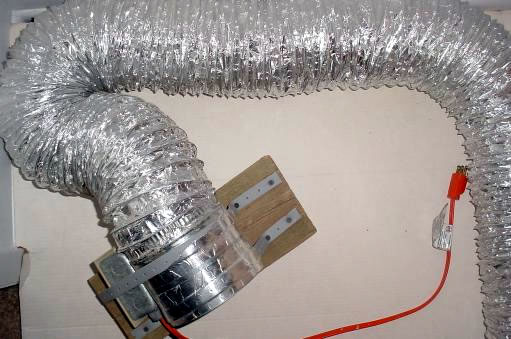
In the next photograph the open design is shown which could be danger
if children like to play in the crawl space. (Yes, I have heard home
owners telling me their children like to play in the crawl space and
were very happy with the white clean plastic barrier I installed and
that the system took care of the radon problem in that space too.)
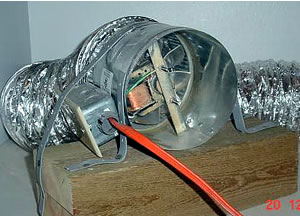
THE SOLUTION FOR SYSTEM A
To solve the problem we placed a draintile pipe with radon barrier
material above it covering the entire crawl space floor, with enough
slack so that the barrier material can adjust sufficiently as it
deflates. Barrier material is completely caulked against the foundation
wall as it was installed following EPA standards.
The resulting new system was able to bring radon level down to below
4.0 pCi/L without any problems.
Higher quality points (a)
and (b) are improved with these changes, point (c) is not changed with
this.
SYSTEM B
PROBLEM: A NOISE ISSUE
 |
When the second
system was looked at in detail there were a few more things to improve,
than what the original complaint was. Although the EPA guidelines state
that systems do not have to be upgraded to EPA standards, the home
owner wanted to upgrade the system on most aspects. According to the
age of the fan the system must have been installed when the previous
buyer bought this house in the second half of the year 2000.
I was called by
current home owner because the system made so much noise that the he
could not sleep at night and was considering turning off the system at
night.
At first glance,
nothing obvious seems wrong with it. Here is the exterior view of the
system I found:
|
| |
|
Further investigation
shows:
The noise that the home
owner complained about is caused by:
1) Fan has discharge point
at the exact point where home owners bed is on second floor in master
bedroom. Measured through the wall when asleep the home owners head is
within 20 inches from the discharges point shown in photograph, yet on
the inside of the wall. (See picture above for the discharge point)
2) All downspout pipes are installed with the upper part into the lower
part (top-into-bottom). This causes extra friction and air loss at each
junction/connection which were not caulked. The extra friction causes
extra metallic noises echoing through downspout.
[Note: A recent discussion
after this letter first posted has given some arguments in favor of
this type of top-into-bottom installation when using downspout
material, although others prefer the bottom-into-top downspout
installation.]
| 3) No caulk is used at
transition point PVC to downspout. This causes a rush of air (and
radon) loss with similar noise at the base of downspout. The other side
of the wall has a couch in living area where noise from this side can
be heard. |
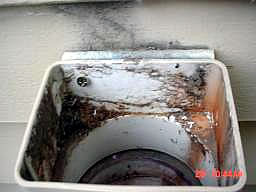 |
4) Two windows of master
bedroom within 10 feet of discharge point that is not 2 feet above it.
(Does not meet EPA standards)
| 5) Fan is 5 years old and
does not appear to be causing an excessive vibration problem, but all
brackets are solidly screwed into wall with long screws, eliminating
the effectiveness of the bubble wrap vibration isolation padding that
is used. This solid connection as well as the solid connections along
downspout are a cause of transfer of vibration into wall and noise on
inside. Improvement of this is possible. |
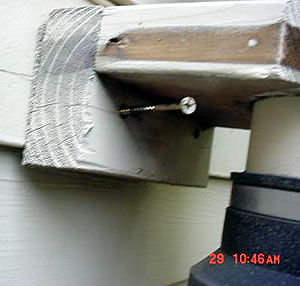 |
6) Interior part of the
system uses self made PVC connectors. These are made from PVC, caulk
and cardboard. These cause large noise in crawl space which because it
is placed directly under the return duct work causes the metallic duct
work to pick this noise up via its internal resonances and transport it
into living room directly above.
Other remarks about this system are:
7) System has no label.
Thus it is not known who installed it, nor identifying any part of it
as a radon system.
| 8) There is a soffit vent
straight above the discharge downspout point within 10 feet. Soffit
vents are designed to be natural entry ways for outside air, thus
potential of radon drawn into attic can be a concern. |
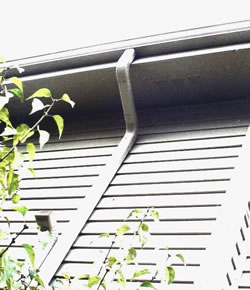 |
| 9) When electric plastic
hard PVC conduit was dis-assembled from fan it immediately broke off
from the box as shown below. There was no force involved to the extent
that this must have been cracked before. |
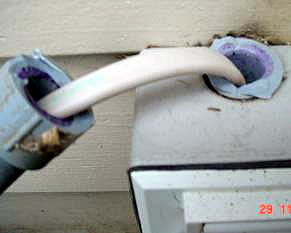 |
10) Moisture protected
electric box had two holes drilled in back that were used as screw
holes to attach box against wall. These holes were not caulked. These
are potential entryways for moisture. In addition, no caulk was used on
back of box to protect water infiltration into wall from between box
and wall.
| 11) Electric box when first
opened was found with a substantial pile of small wood chips in the
bottom. These wood chips appear to have been brought in by insects
(ants?) through the existing openings pointed out in item 10) above.
These dry wood chips form a fire hazard if piled up high enough to
reach the contacts. |
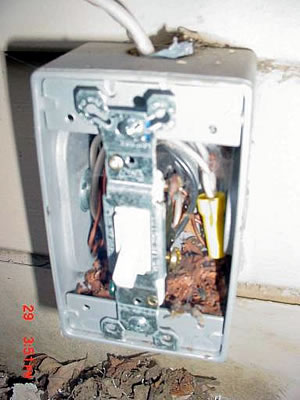 |
| 12) Without the benefit of a
moisture capture and discharge system above the fan to the outside
moisture drained through the fan . Consequently a significant
colorization red and black seems to signify mold built up on the inside
of the pipe (To be fair, no mold test was done to verify this.). This
same built up was visible in the pipe to downspout adapter that was
shown in 3) located above the fan. |
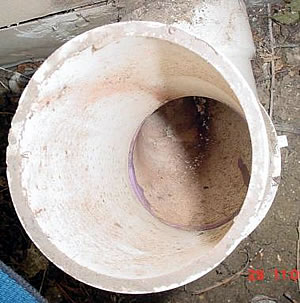 |
13) Pipe from radon
extraction cavity under slab into crawl space was using part of the
already small crawl space entrance. The crawl space is only 3 feet
high, with duct work and plumbing pipes hanging below the floor joists
immediately behind entrance as well as an upward sloping dirt floor,
making it a very cramped entry. There were several opportunities to
install this pipe differently although it would have taken somewhat
more material and time to accomplish by the original mitigators. This
does not follow EPA standards and is considered a bad practice.
However this aspect of the system was not changed in the end. The
yellow radon identification label was placed by us, not by the original
installer. |
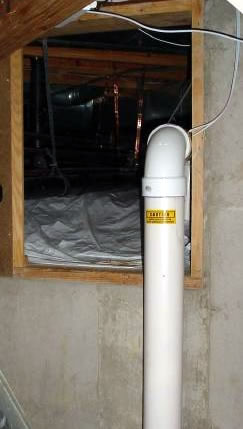 |
| 14) Inside crawlspace the
connection pipes are choked down with self made PVC pipe
Tee’s in two locations. Self made Tee's with two inch PVC
pipe caulked with urethane caulk into a hole inside the four inch pipe
(This is not EPA) makes more noise than standard Tees. This was part of
the cause of the noise in the living area above. One self made Tee in
the system is shown below: |
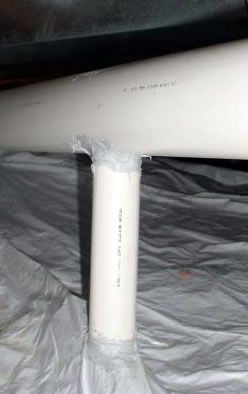 |
| 15) The Tee's were removed and cardboard
cylinders were found to be used as radon collector devices under the
plastic. (Not a durable material and Not an approved EPA material for
radon systems). |
|
| Inside this cardboard pipe there was visible
black mold growth. |
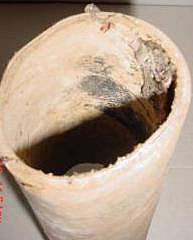 |
| The next picture shows
the two self made PVC pipe Tee’s compared to a standard pipe
4”x2” Tee on the right. |
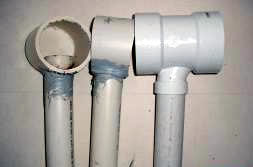 |
16) There were two
unfinished storage areas. The perimeter expansion material and grooves
in concrete slab were only caulked for approx. 10%.
17) Sump pit in seperate
unfinished area was not hermetically sealed (Not EPA).
THE SOLUTION FOR SYSTEM B:
After looking for alternative locations and their consequences on noise
and checking the ten foot requirement for the distance of the radon
dicharge point from windows on the second floor the home owner decided
that he wanted to have a low noise replacement system installed at the
same location.
After disassembling the
exterior part of the existing system a Super Low Noise Exterior system
was placed with special features to minimize exterior and interior
noises and vibrations as shown in the following two pictures:
 |
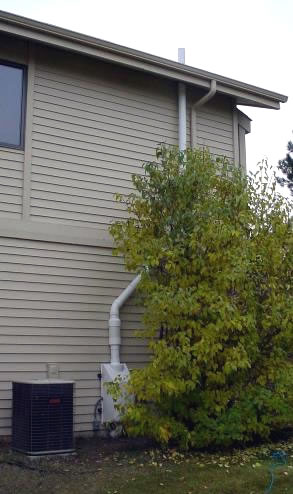 |
Exterior noise level
reduced significantly as well as on both interior levels.
In the crawlspace, modifications were made such as 15 ft length of
draintile pipe was attached to each side of the two new
4”x2” Tee’s under the radon barrier (i.e.
60 ft.of capped off draintile pipe total). Insulation was used to
dampen noise where the 4” air stream is forced into a
2” air stream where the maximum speed of air increases a
factor 4 compared to a 4” diameter pipe (if air can be
considered incompressible for this purpose). The noise level inside was
significantly reduced although the return ductwork is a very powerful
resonant amplifier and not all noise was eliminated, but home owner
stated he can now live with it.
The Sump pit was hermetically sealed and 15 tubes of caulk had to be
used to finish caulking of the two unfinished storage areas.
Higher quality point (c)
is addressed with these modifications, points (a) and (b) are not
changed.
|















